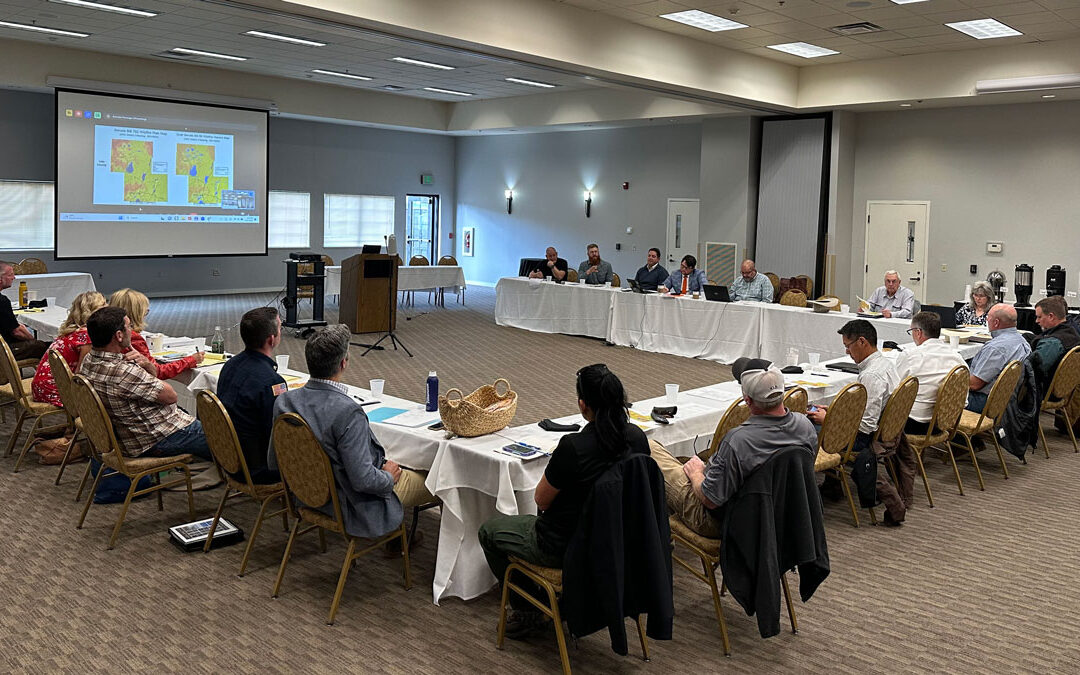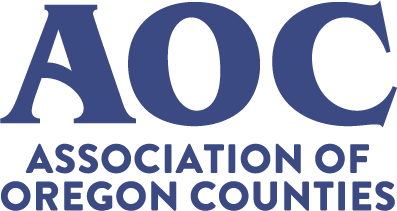
Oct 23, 2023 | AOC Advocacy, Natural Resources
Since the state legislative session adjourned in June, the natural resources portfolio at the Association of Oregon Counties (AOC) has been active implementing AOC’s policy priorities passed during the 2023 session and queuing up work for the upcoming 2024 short session.
Senate Bill 80 Regional Wildfire Hazard Map Meetings
Pursuant to Senate Bill 80 (2023), the Oregon Department of Forestry (ODF) and AOC hosted a series of wildfire hazard map meetings throughout the state, beginning the first week of September and concluding Oct. 11.
The State Insurance Commissioner, Building Codes Division Administrator, Oregon State University, ODF, and the State Fire Marshal traveled to nine locations around the state to engage directly with county commissioners, planners, administrators, and emergency managers. During these meetings, counties and ODF discussed the mapping process, hazard identification methodology, and details of the draft hazard maps. ODF will now begin updating the administrative rules to include information collected during those meetings, as well as factoring in the changes made in Senate Bill 80. Counties will be represented on the rules advisory committee, and can continue to raise issues to ensure necessary changes are considered.
Oregon Department of Fish and Wildlife Sage-Grouse Action Plan Update
The Oregon Department of Fish and Wildlife (ODFW) recently began conversations around updating the Oregon Statewide Sage-Grouse Action Plan. The Sage-Grouse Action Plan designates the core and low-density habitats encompassing the populations and assesses the effects these conservation strategies have on the communities where the bird resides. ODFW conducted public outreach around the habitat map updates and have now turned their attention to the “Greater Sage-Grouse Conservation Assessment and Strategy for Oregon: A Plan to Maintain and Enhance Populations and Habitat.”
AOC staff have been asked to serve on this agency strategy plan update. AOC originally produced the appendix in February 2011. AOC has also been asked to update “Appendix VI: Socio-Economic Profile and Analysis of Oregon Counties included in the Greater Sage-Grouse Conservation strategy for Oregon” by the end of this calendar year. AOC staff has begun this work and is gathering information from the eight impacted counties that are within the current range of the greater sage-grouse in Oregon.
Elk Depredation Program
This session, Rep. Bobby Levy (R-Echo) introduced House Bill 3052 (2023) which would have established a task force on elk and deer damage compensation funding. Although that bill did not receive a floor vote, the House Interim Committee on Agriculture, Land Use, Natural Resources, and Water under the chairmanship of Rep. Ken Helm (D-Beaverton and Cedar Hills), created an interim work group to find a path forward on this issue.
The workgroup is made up of 15 individuals and has two primary deliverables. First, they are tasked with producing a short report that documents the workgroup process, discussion, and recommendations on the ideal structure for the program. Second, the workgroup will find an appropriate level and source funding and develop bill language for the upcoming 2024 legislative session.
AOC staff will continue to keep the membership apprised of these activities and developments as the interim continues.
Contributed by: Branden Pursinger, AOC Legislative Affairs Manager

Jun 26, 2023 | Natural Resources
Counties have until July 12th, 2023 to submit allocation elections between SRS and USFS 1908 payments – and elections between SRS Title I, II, and III – to AOC.
Federal Fiscal Year (FY) 2023 (County FY 2024) Secure Rural Schools (SRS) Program payments are projected to be greater than United States Forest Services (USFS) 1908 Act 25 percent timber harvest (USFS 1908) payments for all Oregon counties.
Please send the “Oregon Election Form FY24” for your county to Branden Pursinger at AOC to ensure all forms are submitted to DAS by the deadline.
Contributed by: Branden Pursinger, AOC legislative affairs manager

Jun 14, 2023 | AOC Advocacy, AOC News, Natural Resources
The Association of Oregon Counties (AOC) has continuously engaged with the legislature, state agencies, and stakeholders in the development of comprehensive wildfire policies for numerous sessions. By focusing on thoughtful, effective, and regionally tailored wildfire policy, AOC has been able to ensure the county perspective is not only at the negotiating table but included in the implementation of statewide policy on wildfire.
Senate Bill 80B (2023) makes many technical changes to the 2021 Wildfire bill, SB 762, including revisiting the statewide wildfire risk map. Based on AOC Natural Resources Steering Committee principles and discussions, AOC staff and steering committee chairs worked with bill sponsor Senator Jeff Golden (D-Ashland), the Oregon Department of Forestry (ODF), and Wildfire Program Advisory Council Chair Mark Bennett and Director Doug Grafe on statutory changes with the goal of an improved statewide wildfire hazard map.
Upon passage of SB 80, statute now requires that, “to ensure local characteristics in each area of this state are considered in the mapping process and before the draft map is released, the department shall meet with county commissioners and their staff in eight in-person meetings throughout this state.”
The bill goes on to say that after those meetings occur and the map is released for public comment, counties will have one additional opportunity to meet with ODF to discuss additional concerns and potential changes to the map. This process must be “interactive and does not consist solely of delivering information in a top-down manner.”
Finally, to ensure that counties have an active role in the wildfire mapping process, ODF stated on the legislative record that, “The department will receive and consider all comments and concerns for integration into the map, and if they are not integrated, an explanation on why will be provided.”
These county-ODF meetings will be scheduled in coordination with the AOC District Meetings this fall. AOC staff is meeting with county planning directors in advance of the fall ODF meetings to ensure counties are prepared to engage meaningfully in the map review process.
“We look forward to meeting with county commissioners and staff as we put the Wildfire Hazard Map together later this year,” said Cal Mukumoto, Oregon State Forester. “Through working together with counties we were able to craft language that works for both parties. Knowing the local concerns and issues faced in specific areas will help us make a map that is beneficial statewide.”
Contributed by: Branden Pursinger, AOC legislative affairs manager

Apr 24, 2023 | Natural Resources
On April 14, the United States Forest Service (USFS) announced the release of $228 million for the Secure Rural Schools (SRS) payments, with $45.6 million coming to Oregon counties. A few days after, the Bureau of Land Management (BLM) announced $25.6 million in payments to Oregon counties under the Secure Rural Schools and Community Self-Determination Act. This means over $70 million will be coming to Oregon to help local governments remain operational.
Counties rely on SRS payments to provide numerous critical services for their communities such as infrastructure, education, conservation projects, search and rescue missions, and wildfire prevention programs. For USFS SRS payment details by county, click here – Oregon is on page 55.
“I want to give a huge thank you to Senators Wyden and Merkley for their continued efforts and sponsorship of the Secure Rural Schools Program,” said Gina Nikkel, AOC executive director. “$70 million coming to Oregon counties to help administer programs and provide essential services to our citizens is greatly appreciated. We cannot say thank you enough for all their continued efforts and the strong partnership we have.”
In the years following the establishment of the USFS in 1905, the national forest system tripled in size across the nation. To compensate counties for potential losses of tax revenues, Congress approved the Act of May 23, 1908. This Act allowed the USFS to distribute a portion of revenues from timber sales, mineral leases, recreation, grazing, and more to the counties containing the national forests and grasslands. In 2000, Congress passed the Secure Rural Schools and Community Self-Determination Act to help stabilize fiscal support for rural county services. In 2021, the Bipartisan Infrastructure Law reauthorized SRS payments through Fiscal Year 2023.
Public land counties rely on programs like SRS and Payments in Lieu of Taxes (PILT) to help maintain their budgets while bearing the responsibility of non taxable federal lands. While these payments represent a fraction of what counties would collect from property taxes and timber receipts, they are critical for local governments to meet their governing missions. The last time authorization for SRS lapsed in Fiscal Year 2016, counties saw an 80 percent decrease in federal forest payments.
Contributed by: Branden Pursinger | Legislative Affairs Manager

Mar 22, 2023 | Natural Resources
Following the passage of SB 762, the 2021 Legislative Session’s comprehensive wildfire policy, the Association of Oregon Counties (AOC) took an active role in ensuring its implementation information was provided to county staff and elected officials by state agencies. AOC hosted webinars regarding the state drawn wildfire map during the summer and the AOC Annual Conference featured a panel discussion entitled “Wildfire and the Changes Brought by SB 762.” The association continued discussions thereafter.
Because of AOC’s continued engagement and direct dialogue with our state partners and legislative leaders, Senator Jeff Golden, who championed the 2021 legislation, assured AOC that advanced notice will be provided to commissioners, judges, chairs, and counties when wildfire related issues come before the Senate Committee on Natural Resources and Wildfire Recovery, a committee that he chairs.
The AOC conference panel featured four speakers and was moderated by Baker County Commissioner and Wildfire Programs Advisory Council Chair, Mark Bennett.
Speakers:
- Wildfire Programs Director Doug Grafe reviewed implementation process of all agencies;
- Department of Land Conservation and Development (DLCD) Director Brenda Bateman overviewed the DLCD Wildfire Report;
- Oregon State Fire Marshal Mariana Ruiz-Temple presented on the Community Wildfire Risk Reduction Grant, as well as others available through her department (these grants are aimed to help protect people, property, and communities from wildfire through various forms of risk reduction programs);
- Oregon Department of Forestry Wildfire Chief Mike Shaw covered the pullback of the Wildfire Risk Map as well as the public hearings they held throughout the state after the map came out.
After the panel presented, Commissioner Bennett provided Senator Golden, who was in the audience for this session, the opportunity to address those in attendance. As the Senator who helped shepherd the legislation through both chambers it was crucial to hear his thoughts on the bill’s implementation. Due to limited time for questions and answers following the conference panel, AOC organized a virtual Q&A session on Tuesday, December 13.
At the December 13 meeting entitled “Wildfire Meeting, a Q&A with Commissioners,” those in attendance were joined by original panelists, DLCD Policy Advisor Palmer Mason, Senator Golden, and State Forester Cal Mukumoto. After a few introductory remarks by the panelists, the remainder of the meeting was spent answering questions. Grafe made reference to a report from the Rogue Forest Partners regarding resiliency efforts underway in the Rogue Basin, Commissioner Bennett, Chair of the Wildfire Programs Advisory Council, referenced the council’s final 2022 Annual Report on recommended changes, and Chief Shaw shared the “Key Issues Identified in Review of the Wildfire Risk map Feedback.”
One issue that got a lot of attention during the December 13 meeting was the inability of counties to implement SB 391 (2021), which allows for the rural residential Accessory Dwelling Units (ADUs) due to the statutory requirement that statewide risk maps first be adopted. AOC staff is working with DLCD, county planning staff, and legislators on a legislative concept that would decouple rural residential ADU authority from the wildfire risk map while maintaining appropriate wildfire risk mitigation measures.
All of the panelists asked that their contact information be shared as a way to be available to answer any additional questions that might arise:
Senator Jeff Golden (D-Ashland) – sen.jeffgolden@oregonlegislature.gov
Wildfire Program Advisory Council Chair and Baker County Commissioner Mark Bennett – mbennett@bakercounty.org
Office of the Governor Wildfire Programs Director Doug Grafe – doug.c.grafe@oregon.gov
Department of Forestry State Forester Cal Mukumoto – cal.t.mukumoto@odf.oregon.gov
Department of Forestry Wildfire Division Chief Mike Shaw – michael.h.shaw@odf.oregon.gov
Office of the State Fire Marshal State Fire Marshal Mariana Ruiz-Temple – Mariana.Ruiz-temple@osp.oregon.gov
Department of Land Conservation and Development Senior Policy Advisor Palmer Mason – palmer.mason@dlcd.oregon.gov
Contributed by: Branden Pursinger | Legislative Affairs Manager





